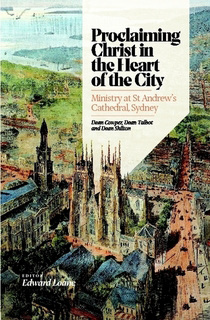Proclaiming Christ in the Heart of the City: Ministry at St Andrew’s Cathedral, Sydney.
EDWARD LOANE (ED.)
ST ANDREW’S CATHEDRAL, 2019.
The last two years have seen significant anniversaries for St Andrew’s Cathedral, Sydney. The year 2019 was the bicentenary of the laying of its foundation stone, and 2018 marked 150 years since its eventual consecration. It is fitting therefore that this volume has been produced to mark both occasions. It is even more fitting that the focus of the volume is not on the building itself, but on the building of Christ’s Kingdom through the proclamation of the gospel in and through the ministry of the cathedral. As Archbishop Glenn Davies writes in his foreword, “this book focuses upon the living testimony of our cathedral, its living stones, rather than its static stonework.” (p. xii).
The opening chapter by Loane charts the history of Anglican cathedrals, their purpose and particular characteristics. Along the way he answers the common critique that Anglican cathedrals “are unreformed vestiges of the medieval church which have no place in Protestant Christianity.” (p. 4) Tracing sources dating back to the English reformers, Loane shows that Protestant cathedrals were envisioned as serving both an evangelistic and a training purpose. With a shortage of clergy able to preach, Cranmer considered cathedrals to be places that ought to function as centres of preaching excellence. The reformers’ notion of cathedrals serving as central churches from which bishops could direct the mission of the diocese through preaching and training of ministers was the reason why cathedrals were retained, and was also viewed by the reformers as returning them to their original Augustinian purpose (p. 22). The chapter also discusses reasons why this hope was largely not realised in the ensuing centuries, and how by the mid-19th century cathedrals had become ideal venues for re-establishing the ceremonial ritualism that had characterised the medieval church. At the same time Evangelicals continued to conceive of cathedrals as centres of mission, preaching and leadership training. It was during this contested era that the trajectory of the Sydney cathedral was shaped. In 1857, Bishop Barker outlined the purpose of the cathedral to be the “parish church” of the whole diocese where the diocesan “chief pastor”, the bishop, could minister and preach. (p. 41).
Building on this foundation, the central section of the book consists of four chapters, the first three dedicated in turn to the Cathedral’s longest-serving deans: William Cowper (by Peter Bolt), Albert Talbot (by Colin Bale) and Lance Shilton (by Edward Loane). The fourth chapter (by Jane Tooher) considers the contribution of William Cowper’s first wife Margaret. Each of these biographical chapters give real insight into the nature of the ministry at the cathedral during those eras. The deans were chosen not only because were they the longest-serving, but also because the eras in which they served were so formative.
Australia’s first native-born clergyman, William Cowper, emerges in Bolt’s portrayal as someone eminently well prepared in the first half of his life for the preaching and ministry-training priorities that remained his priorities during his long tenure as dean (1858-1902). The chapter by Colin Bale on Dean Albert Talbot (1912-1936) explores his role as a more liberal evangelical dean, in particular his involvement in the social issues of Sydney’s industrial working class. Dean Lance Shilton (1973-1989) is shown by Loane to be a clear champion of the cathedral as a centre for evangelism and public engagement. Having had experience in city-centre churches in Melbourne and Adelaide, Shilton was convinced of the strategic role of such churches and his cathedral ministry was a natural extension of that. Shilton summed up the purpose of cathedral ministry as “Communication, that is communication with God in worship, communication with other Christians in fellowship, and communication with the whole city and beyond in evangelism.” (p. 146)
The beautiful chapter on William Cowper’s first wife Margaret by Jane Tooher centres on the last year of her life, as narrated by William. Margaret died four years before William’s appointment as dean, and as he reflects on the spiritual life and tenderness they shared, and Margaret’s boldness in facing death, it is clear how formative this experience of grief was on his ministry over the coming decades.
The final chapter, written by the current Dean, Kanishka Raffel, gives a wonderful insight into the present workings of the cathedral, and the prospects of ministry in that place over the coming years. Such ministry he envisages to be in continuity with his predecessors’ evangelistic focus and keenness for seizing the opportunity for public witness and proclamation to the city. This book fulfils its promise. We meet afresh the ‘living stones’ who through the decades have sought to proclaim Christ, make disciples and show Christ’s love to the city and beyond.
// Gavin Perkins, NSW